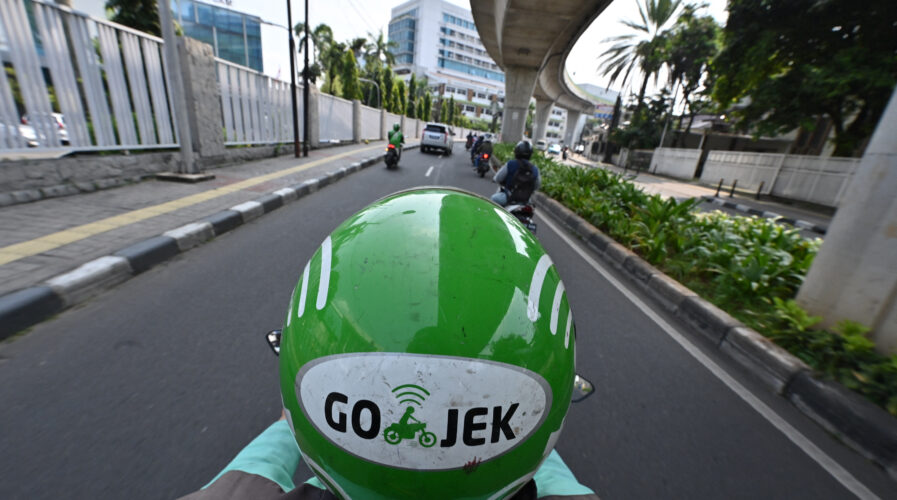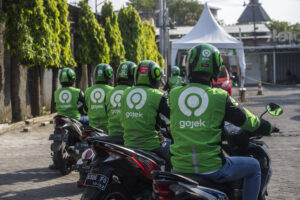
Gojek: How GoFood is leveraging its most powerful ingredient – data. (Photo by ADEK BERRY / AFP)
Gojek: How GoFood is leveraging its most powerful ingredient – data
- The average income of GoFood MSME merchants increased by 66% YoY in 2021, which Gojek believes is attributed to its technology that helped merchants stay resilient amid the pandemic.
- A recent research indicated that GoFood is the most owned and most used online food delivery app in Indonesia, with the highest transaction value in 2021 (IDR 30.65 trillion).
- To date, Gojek has more than one million registered GoFood merchants on the platform in Indonesia alone, of which 99% of them are MSMEs.
GoFood, the food delivery arm of Indonesia’s superapp Gojek, has been leading the archipelago’s food delivery industry for years now. In fact, since it was introduced in 2015 as Gojek’s start to its superapp journey, GoFood has been a significant contributing factor to the former’s growth.
Considering how micro, small, and medium enterprises (MSMEs) are the backbone to the Indonesian economy, Gojek has, since its early days, swooped in to help answer the challenges and create a more level playing field for MSMEs to spread their wings. In short, Gojek via GoFood and other services it provides, have been accelerating the growth of MSMEs to do business in the digital economy.
A research by the University of Indonesia showed that four out of five MSMEs believe that GoFood has helped to spur their business growth as they are able to leverage on benefits including GoFood promotion opportunities, broader market access, ease of operational management through the GoBiz application and entrepreneurship training.
Tech Wire Asia recently had the chance to catch up with Gojek’s head of food and Indonesia sales & operations Catherine Sutjahyo to discuss how the country’s most valuable company leverages on data to understand the needs and preferences of both its MSMEs and consumers.
Over the last couple of years, competition has been cut-throat in the food industries, especially in Asia. What sort of technologies GoFood is adapting to enhance its services?
The pandemic has been a catalyst for Indonesia’s digital economy, with an increasing number of individuals, both consumers and culinary MSME businesses, relying on online platforms for their daily needs. In line with this trend of more consumers and businesses going digital, we are optimistic that online food delivery services in 2022 will continue to grow.

Competition has been cut-throat in the food industries, especially in Asia. (Photo by BAY ISMOYO / AFP)
With this in mind, Gojek and GoFood are continuing to innovate and improve our product and service offerings for all members of our ecosystem – our consumers, MSME merchants and driver partners. Our aim is to ensure we can continue meeting their daily needs and the growing demand for digital solutions. We are constantly adapting and leveraging technologies, which include; tapping into data personalization to drive hyperlocal experiences. For us, hyperlocal means driving consumers’ appetite towards local culinary choices within their vicinity.
As such, we continue to utilize data personalization technology to boost the exposure of local MSME merchants. Consumers will get their very own culinary recommendations from nearby MSME merchants per their unique preferences, providing them with a more enjoyable food discovery experience. We also have our Multiple Orders (Order Sekaligus) feature that allows consumers to order from multiple restaurants in a single location, with only one delivery fee.
Since its launch, it has expanded into 41 locations across seven cities, including Jabodetabek, Bandung and Surabaya. Earlier this year, we also launched a pilot project for the adoption of automated robotic technology aimed at improving operational efficiency and driver convenience, particularly for GoFood Multiple Orders. The robot will collect orders from several restaurants and place these at a single pick up point for our driver-partners to collect and deliver. Such technology adoption is the first in Indonesia’s online food delivery landscape.
Could you share how GoFood uses data to optimize and enhance its offering — especially during the pandemic?
Data analytics plays a crucial role in GoFood’s business, especially in the development and enhancement of the GoFood app, where we are always looking for innovative ways to meet the diverse and evolving needs of our users and merchants. For example, GoBiz, Gojek’s all-in-one merchant app, provides merchants insights on their transactions and performance, allowing them to more effectively strategize for their businesses.
Data also gave us the insight that many GoFood merchants were first-time business owners, and it was based on these findings that KOMPAG (GoFood Partners Community) was set up to serve as an official forum for MSME merchants to network and share best practices with each other, and provide them with education and training. KOMPAG has over 119,000 members in 70 cities today, and has supported the growth of numerous small culinary merchants.
Additionally, GoFood leverages data analytics to provide menu recommendations and the most relevant searches, tailored to each user’s individual preferences. These are curated and displayed based on user behaviors and their order history to better cater to them. For instance, our #Rekomendasik campaign, which was launched this year, gave users a curated hyperlocal menu that was built based on their locations and order timings, and comprised merchants with high ratings and good reviews.
In addition to personalized search and recommendations, the campaign also gave targeted promos to users, ensuring they get the most relevant deals based on their preferences. By tapping on data, we are continuing to further optimize our GoFood offerings to provide more customized solutions and enhanced experiences for both merchants and users.
What are the number of GoFood merchants to date? And what is the number of app downloads so far?
To date, we have more than one million registered GoFood merchants on the platform in Indonesia alone, of which 99% of them are MSMEs.

Gojek riders wait for their delivery orders at a distribution centre in Surabaya on May 17, 2021, as Gojek and Tokopedia unveiled a merger to form GoTo Group, creating the largest tech firm in the world’s fourth most populous country. (Photo by Juni Kriswanto / AFP)
Would you be able to share statistics on GoFood, such as the number of deliveries made throughout the pandemic in the last two years or so?
We are now seeing a rising number of merchants embrace technology to grow – for example, the number of GoFood partners who utilized Gojek’s digital promotion tools during Ramadan this year grew by 46% compared to the previous year. Research by the University of Indonesia also showed that 4 out of 5 MSMEs believe that GoFood has helped to spur their business growth as they are able to leverage benefits including GoFood promotion opportunities, broader market access, ease of operational management through the GoBiz application and entrepreneurship training.
At the same time, Gojek’s services are also designed to improve the daily lives of millions of consumers by providing them with the goods and services they need in the most convenient way possible. During Ramadan this year, we saw the number of consumers using GoFood grow by 25% as compared to Ramadan 2021. GoFood also continues to be consumers’ platform of choice – recent research by Tenggara showed that GoFood is the most owned and most used online food delivery app in Indonesia, with the highest transaction value in 2021 (IDR 30.65 trillion).
What does success look like right now for Gojek and GoFood in particular?
For Gojek and GoFood, what is important for us is to continue creating added value for everyone in our ecosystem. We are committed to helping MSMEs grow their businesses, and being able to do that whilst also seeing growth in customer loyalty is what makes us most proud. Based on a survey conducted by the University of Indonesia1 last year, the average income of GoFood MSME merchants increased by 66% in 2021 (YoY), showing how GoFood’s technology has helped merchants stay resilient amid the pandemic.
Consumers also continue to trust GoFood for their culinary needs. According to the same survey, the majority of consumers are loyal Gojek customers, with 86% of consumers surveyed willing to continue using Gojek services including GoFood, regardless of promo availability. We have also seen our loyal user base strengthen – our GoFood Plus subscription package that gives consumers instant access to various discounts and promotions including delivery fee discounts, has been very popular among consumers, with subscriptions growing almost 5x from January to June 2021.
We are proud of what we have been able to bring to our consumers and merchant-partners so far, and will continue to develop and enhance services to cater to consumers’ needs while providing the best possible opportunities for our merchants.
READ MORE
- Ethical AI: The renewed importance of safeguarding data and customer privacy in Generative AI applications
- How Japan balances AI-driven opportunities with cybersecurity needs
- Deploying SASE: Benchmarking your approach
- Insurance everywhere all at once: the digital transformation of the APAC insurance industry
- Google parent Alphabet eyes HubSpot: A potential acquisition shaping the future of CRM


